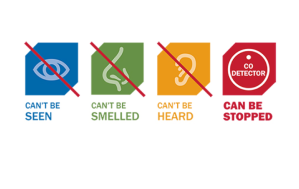By Sofia Chaudhary
SCHAUD3@emory.edu
As the temperature drops and winter sets in, let’s remind families to keep their children safe.
Carbon monoxide-The invisible gas that kills
According to the CDC, there are around 15,000 ED visits and 500 deaths annually due to unintentional, non-fire related carbon monoxide (CO) poisoning. There is a steep rise of these incidents during the months of November to February every year. These CO poisonings can be easily prevented with proper vehicle, appliance, and heating system maintenance along with education on correct usage of heating and cooking devices. The National Poison Data System shows that the home is the primary site for carbon monoxide exposure with the second most common site being the workplace. Children in comparison to adults can develop carbon monoxide poisoning more rapidly due to faster respiratory rates and increased oxygen utilization.
So what happens when one inhales this odorless, tasteless gas? In brief, CO rapidly crosses our body’s capillary membrane and displaces one oxygen molecule from hemoglobin, binding more than 200 times as strong to the hemoglobin and reducing the ability of the remaining oxygen molecules to be released. Oxygen delivery to peripheral tissues is reduced. In addition, CO can disrupt cellular respiration, worsening oxygen utilization and displaces nitrous oxide from proteins causing vasodilation. The CDC reports that an elevated carboxyhemoglobin (COHb) level of 2% in a nonsmoker and 10% in a smoker suggests CO poisoning. The clinical status of a patient, however, is a more accurate depiction of the severity of illness after CO exposure. The most common symptoms of carbon monoxide poisoning include headaches, dizziness, nausea, or vomiting and can often be misdiagnosed as a viral illness. Infants may present with fussiness or irritability. More severe poisoning and prolonged exposures can cause confusion, ataxia, altered mental status, coma, arrhythmias, myocardial ischemia or infarction, lactic acidosis, metabolic acidosis, acute renal failure, or non-cardiogenic pulmonary edema.
Prevention strategies for CO poisoning:
• Install carbon monoxide detectors with a back up battery on every level in your home, at least 15 feet away from fuel burning appliances. Be sure to have one near all separate sleeping areas.
• Check your CO detectors twice a year, when you change your clocks in the spring and fall. Remember these detectors do not take the place of your smoke alarms- you can often find dual detectors.
• If the CO alarm goes off exit the home immediately and call for help.
• Do not use charcoal grills, generators, camping stove, gasoline powered tools or pressure washers inside the house, the garage, or near the windows. Generators should be outside and 20 feet away from all windows, doors, and vents.
• Have water heater, gas clothes dryer, and gas stove serviced by a technician once a year or as recommended by manufacturer. All vents for these appliances should be kept clear and free from debris.
• Have heating system/furnace checked annually and make sure the pilot light is working properly. Have the chimney for fireplaces cleared and checked annually to prevent debris buildup with subsequent CO retention.
•Do not keep your car running inside the garage, even if the garage door is open. Have your car’s vehicle emission system checked annually.
•Do not use your gas stove to warm the house.
Treatment of CO poisoning starts with removal from source of CO. Supportive care is given in the ER with 100% oxygen non-rebreather mask until the patient is symptom free, usually after 4 to 5 hours. Contact poison control to report incident and receive additional support. Labs are drawn to check COHb level and lactate level (for closed house fires), and EKG for severe poisonings. Elevated lactic acid levels > 10 mmol/L correlates with elevated cyanide levels and cyanide antidotes should be given. Patients with altered mental status or presenting in a coma are intubated and given 100% oxygen. Hyperbaric oxygen is reserved for severe CO poisonings, those presenting with altered mental status, loss of consciousness, COHb levels of 25-30%, showing signs of cardiac disease, or with acidosis. Of note, discharged patients are given instructions to be aware of delayed neurological presentations up to 48 hours after initial exposure and are asked to follow up with PCP 2 weeks after initial exposure for repeat physical and neurologic exam. (Figure 1)
How much is too much?
Bundling kids this winter while riding and resting, we all have worn those “poofy” winter jackets growing up or my ultimate favorite, the bunny suit! Unfortunately, most parents are not aware that what may keep their child warm may also cause injury when worn while sitting in a car seat or booster seat. The issue lies with the ability of these coats and jackets to be compressed when there is an impact and thus creating space between the child and seat belt harness. This additional space can propel the child forward causing additional external and internal injury in addition to some children falling out of the harness itself. Coats and jackets should be removed upon placing a child in a car or booster seat. It is safe to wear sweatshirts and sweaters that children would wear while playing indoors or place a blanket or jacket on child’s lap away from face and over seatbelt. To make sure that the car seat straps are not too loose over the child’s body, parents should do the pinch test. With the harness pulled tight and the chest clip at the level of the armpit pinch the strap with the thumb and index finger at the level of the collarbone (see below-Figure 2). If the strap webs in between the thumb and index then the straps are too loose, if no webbing then the straps are tight enough. If parents want to do the pinch test with thin jackets or to check the safety of their child’s outer layers they should tighten the harness with the outer layer on then remove outer layer and buckle the child again doing the pinch test to see if any extra space was created by this outer layer.
Parents of newborns and infants may want to bundle their little ones in thick blankets or wraps to stay warm. Unfortunately as we know this can increase the risk for suffocation by direct obstruction or by reducing air flow in the space around child’s mouth and nose. A newborn has a tidal volume of approximately one ounce-leaving very little reserve. Parents should be reminded to place their child on their backs on a firm crib mattress with a tight fitted sheet without any additional items in the crib including stuffed animals or bumpers. Sleep sacks are a snug fitting and safe option for babies to keep warm. We also see a rise of suffocation or SIDS during these cold months from co-sleeping. Parents may not realize that it is not only rolling over their child that can cause suffocation but even if something as simple as their arm falling onto the babies face. One option may be to have the crib in the same room as parent if they want to stay close or to use a pack and play in the room with a newborn top mattress section so that it is easy access for mother to reach over to pick up her child. Enjoy the holiday and winter season we hope these few reminders can help you keep your patients and families safe!
(Figure 1-Source CDC)
(Figure-2 Pinch Test-SAFEKIDS.ORG)



